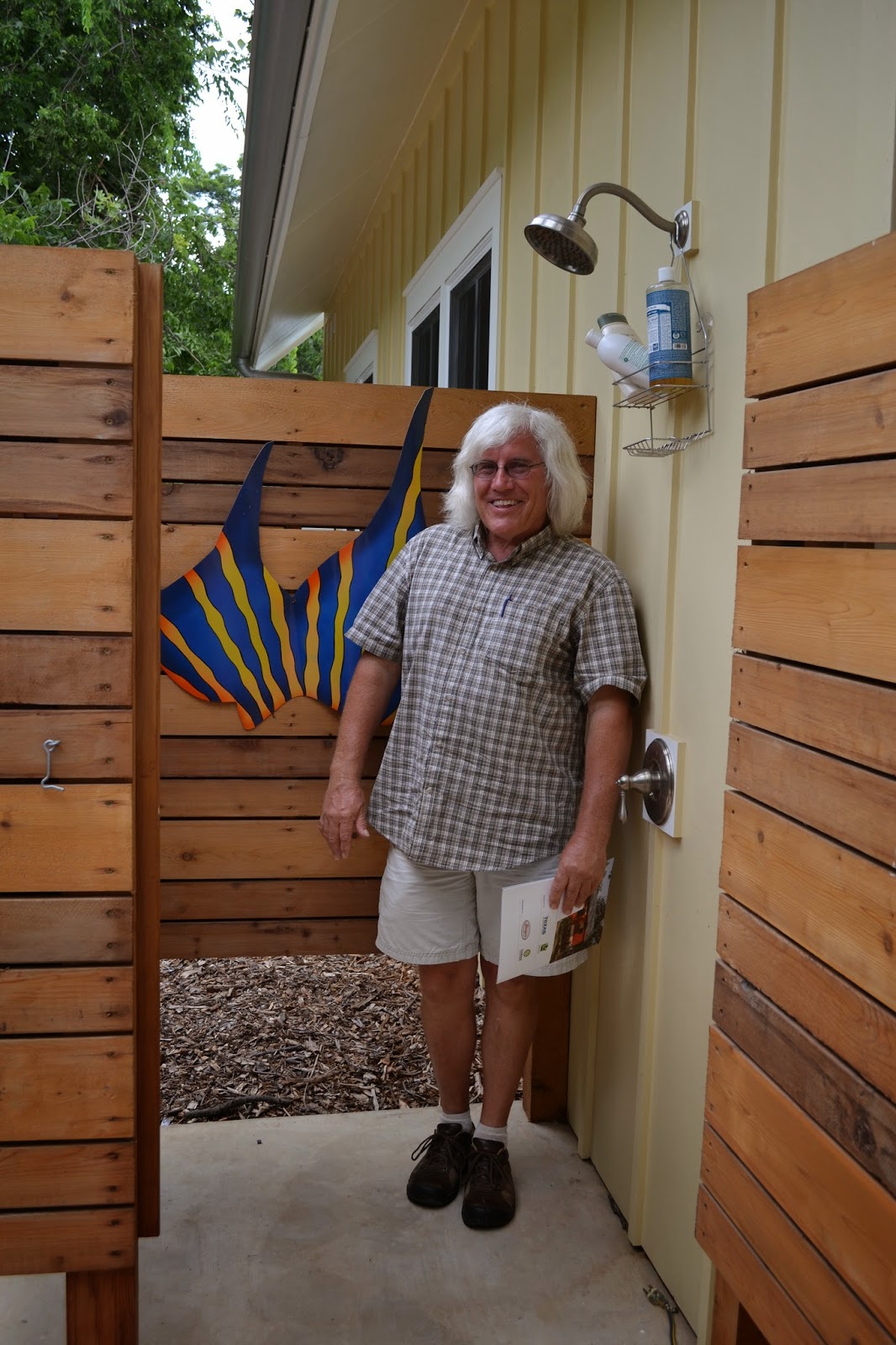 |
| Dwight Richter of Georgetown checks out an outdoor shower on the Cool Home Tour |
Even though I was born here,
I believe that Texas is barely fit for human habitation in the summertime. Every winter when the sky is blue and the air
is cool and dry, I fantasize that the coming summer will finally be the one in
which a sturdy fan, a tall glass of iced tea, and a hefty dose of ecological
self-righteousness will suffice in lieu of air conditioning. In the spring, the balmy breeze through the
open windows is soft as a caress, the rustling trees and the thrum of cicadas are
a lullaby, and I feel kinship with a benevolent Mother Nature. People thrived here for hundreds of years
without air-conditioning; surely I am no less hardy than they.
But every year, usually in
May, a deathly still day arrives when the humidity tops 80 percent and the temperature
has climbed into the mid nineties. Sweat
runs down my back even if I could sit perfectly still, but I can’t sit still
because of a cloud of blood-sucking mosquitoes.
Mother Nature is no longer benign, but rather an uncaring dominatrix
awaiting my eventual return to compost. I
cannot save the planet in this infernal heat.
This year I made it until
June before admitting that I am indeed less evolutionarily fit than my
forebears. My grandmother used to sleep
under a wet sheet to stay cool, but I have more convenient options. With a reluctant twist of the thermostat I both
increased my carbon footprint and sealed myself into a habitable pod, like an
astronaut on the Space Station.
It hasn’t always been the
case that a house was meant to seal us off from the hostile environment. For thousands of years people lived mostly outside
and a shelter was considered adequate if it kept the rain off and the predators
out at night. But being human, and by
nature chronically dissatisfied, we gradually demanded more.
First we began to cook inside,
even though the smoke was deadly until chimneys were invented. Then, however crazy it sounds, we decided to
poop indoors, which clearly required other technological innovations.
Sometime in the latter half
of the twentieth century we decided we needed more space; about a thousand square
feet per person would be very comfortable.
To remind us of our European roots we put a steep roof on the house to
shed snow (no matter that there wasn’t really any snow), decorated with a
stylish Italian façade, and surrounded the house with a lawn like an English
manor, which looks appealing and would be perfect for grazing sheep or croquet,
but you can’t play in the grass because of chiggers, so it is only useful for
mowing practice. Next we wanted a
perfectly modulated indoor climate, even though heating and cooling a home
accounts for almost 50% of residential electricity usage. And to top off the absurdity of our housing
desires we build this modern version of a house several hundred copies at a
time on rocky pastures where there is not enough water to support one cow per
five acres.
On June 8, almost the same
day that I turned on my AC, I also visited some of the homes on the 18th
annual Cool House Tour, sponsored by the Texas Solar Energy Society and Austin
Energy Green Building. The purpose of
the tour is to showcase new homes and remodels that have been designed to be
energy efficient and comfortable, with less negative impact on the
environment. These houses are technologically
advanced, but because they are all one-off projects, they are creative far
beyond anything you might find in a tract home.
HausBar Farm was one of the
most popular homes on the tour. Sitting
on less than two acres in east Austin, this working urban farm has space enough
for a large garden, dozens of hens, ducks, and rabbits, and even a donkey. A 30,000 gallon rainwater tank provides
irrigation for the vegetables and animals and a 22 kilowatt solar array covers
a pole barn in the yard. Although the
house is efficiently insulated and air conditioned, the owners can stay cool
outside on either a shady screened porch or a shady patio beside an inviting
swimming pool. Shade is absolutely the
first, most important step in energy efficiency for Texas. Keep the summer sun off the walls and windows
and make the roof light-colored to reflect the heat, and you have gone a long
way toward reducing energy costs.
A kitchen on the patio allows
the farmers to do their cooking outside in warm weather, so the house stays cooler. A shower is also located on the patio. A regular feature at scout camps and
Caribbean resorts, outdoor showers put the excitement back into bathing, while
also keeping humidity out of the house and lessening the load on the AC unit.
Another home on the tour
economized on space. The young
professional couple packed lots of luxury into 903 square feet. The small size means they used less material
to build, and will spend far less to heat and cool. They will not have to waste a lot of time
cleaning either, and will have time and money to do the fun things they want to
do. Less is more.
Texas can be a hostile
environment, but with a little imagination you can find clever ways of dealing
comfortably and efficiently with summer heat, without having to sleep between
wet sheets.